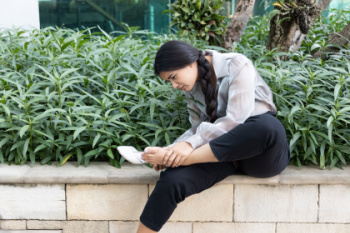
Blisters between the toes are often caused by friction, moisture, or infections. They can be painful and make walking uncomfortable. Symptoms include redness, swelling, and fluid-filled pockets that may burst and cause irritation. Among the causes of blisters are allergies to certain shoes or materials, fungal infections like athlete's foot, or poorly fitting shoes that create friction. Fungal infections often occur in damp environments and may lead to itching, cracking, and peeling skin between the toes. Allergies to shoe materials or detergents can also trigger blisters. Tight shoes or socks that trap moisture can worsen friction, increasing the likelihood of blisters forming. Treatment depends on the underlying cause. For fungal infections, antifungal creams or powders can help, while wearng proper shoes and moisturizing can prevent friction-related blisters. A podiatrist can assess your condition and recommend the best treatment, whether it is antifungal therapy or advice on proper footwear. If you are struggling with blisters between your toes, it is suggested that you schedule an appointment with a podiatrist for professional care and advice.
Blisters are prone to making everyday activities extremely uncomfortable. If your feet are hurting, contact Richard M. Allen, DPM of Idaho. our doctor can provide the care you need to keep you pain-free and on your feet.
Foot Blisters
Foot blisters develop as a result of constantly wearing tight or ill-fitting footwear. This happens due to the constant rubbing from the shoe, which can often lead to pain.
What Are Foot Blisters?
A foot blister is a small fluid-filled pocket that forms on the upper-most layer of the skin. Blisters are filled with clear fluid and can lead to blood drainage or pus if the area becomes infected.
How Do Blisters Form?
Blisters on the feet are often the result of constant friction of skin and material, usually by shoe rubbing. Walking in sandals, boots, or shoes that don’t fit properly for long periods of time can result in a blister. Having consistent foot moisture and humidity can easily lead to blister formation.
Prevention & Treatment
It is important to properly care for the affected area in order to prevent infection and ease the pain. Do not lance the blister and use a Band-Aid to provide pain relief. Also, be sure to keep your feet dry and wear proper fitting shoes. If you see blood or pus in a blister, seek assistance from a podiatrist.
If you have any questions, please feel free to contact our office located in Lewiston, ID . We offer the newest diagnostic and treatment technologies for all your foot care needs.
